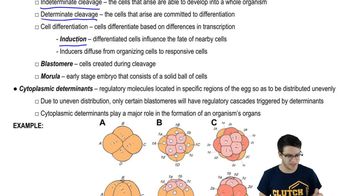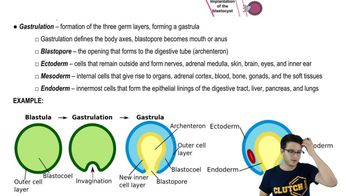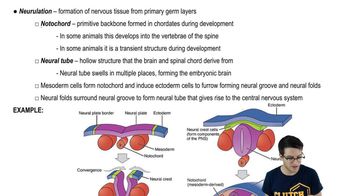Table of contents
- 1. Introduction to Biology2h 42m
- 2. Chemistry3h 40m
- 3. Water1h 26m
- 4. Biomolecules2h 23m
- 5. Cell Components2h 26m
- 6. The Membrane2h 31m
- 7. Energy and Metabolism2h 0m
- 8. Respiration2h 40m
- 9. Photosynthesis2h 49m
- 10. Cell Signaling59m
- 11. Cell Division2h 47m
- 12. Meiosis2h 0m
- 13. Mendelian Genetics4h 44m
- Introduction to Mendel's Experiments7m
- Genotype vs. Phenotype17m
- Punnett Squares13m
- Mendel's Experiments26m
- Mendel's Laws18m
- Monohybrid Crosses19m
- Test Crosses14m
- Dihybrid Crosses20m
- Punnett Square Probability26m
- Incomplete Dominance vs. Codominance20m
- Epistasis7m
- Non-Mendelian Genetics12m
- Pedigrees6m
- Autosomal Inheritance21m
- Sex-Linked Inheritance43m
- X-Inactivation9m
- 14. DNA Synthesis2h 27m
- 15. Gene Expression3h 20m
- 16. Regulation of Expression3h 31m
- Introduction to Regulation of Gene Expression13m
- Prokaryotic Gene Regulation via Operons27m
- The Lac Operon21m
- Glucose's Impact on Lac Operon25m
- The Trp Operon20m
- Review of the Lac Operon & Trp Operon11m
- Introduction to Eukaryotic Gene Regulation9m
- Eukaryotic Chromatin Modifications16m
- Eukaryotic Transcriptional Control22m
- Eukaryotic Post-Transcriptional Regulation28m
- Eukaryotic Post-Translational Regulation13m
- 17. Viruses37m
- 18. Biotechnology2h 58m
- 19. Genomics17m
- 20. Development1h 5m
- 21. Evolution3h 1m
- 22. Evolution of Populations3h 52m
- 23. Speciation1h 37m
- 24. History of Life on Earth2h 6m
- 25. Phylogeny2h 31m
- 26. Prokaryotes4h 59m
- 27. Protists1h 12m
- 28. Plants1h 22m
- 29. Fungi36m
- 30. Overview of Animals34m
- 31. Invertebrates1h 2m
- 32. Vertebrates50m
- 33. Plant Anatomy1h 3m
- 34. Vascular Plant Transport1h 2m
- 35. Soil37m
- 36. Plant Reproduction47m
- 37. Plant Sensation and Response1h 9m
- 38. Animal Form and Function1h 19m
- 39. Digestive System1h 10m
- 40. Circulatory System1h 57m
- 41. Immune System1h 12m
- 42. Osmoregulation and Excretion50m
- 43. Endocrine System1h 4m
- 44. Animal Reproduction1h 2m
- 45. Nervous System1h 55m
- 46. Sensory Systems46m
- 47. Muscle Systems23m
- 48. Ecology3h 11m
- Introduction to Ecology20m
- Biogeography14m
- Earth's Climate Patterns50m
- Introduction to Terrestrial Biomes10m
- Terrestrial Biomes: Near Equator13m
- Terrestrial Biomes: Temperate Regions10m
- Terrestrial Biomes: Northern Regions15m
- Introduction to Aquatic Biomes27m
- Freshwater Aquatic Biomes14m
- Marine Aquatic Biomes13m
- 49. Animal Behavior28m
- 50. Population Ecology3h 41m
- Introduction to Population Ecology28m
- Population Sampling Methods23m
- Life History12m
- Population Demography17m
- Factors Limiting Population Growth14m
- Introduction to Population Growth Models22m
- Linear Population Growth6m
- Exponential Population Growth29m
- Logistic Population Growth32m
- r/K Selection10m
- The Human Population22m
- 51. Community Ecology2h 46m
- Introduction to Community Ecology2m
- Introduction to Community Interactions9m
- Community Interactions: Competition (-/-)38m
- Community Interactions: Exploitation (+/-)23m
- Community Interactions: Mutualism (+/+) & Commensalism (+/0)9m
- Community Structure35m
- Community Dynamics26m
- Geographic Impact on Communities21m
- 52. Ecosystems2h 36m
- 53. Conservation Biology24m
20. Development
Animal Development
Problem 5`
Textbook Question
If an egg cell were treated with EDTA, a chemical that binds calcium and magnesium ions,
a. The acrosomal reaction would be blocked.
b. The fusion of sperm and egg nuclei would be blocked.
c. The fast block to polyspermy would not occur.
d. The fertilization envelope would not form.
 Verified step by step guidance
Verified step by step guidance1
Understand the role of calcium and magnesium ions in fertilization. These ions are crucial for various processes during fertilization, including the acrosomal reaction, fusion of sperm and egg nuclei, and formation of the fertilization envelope.
Consider the acrosomal reaction, which is the release of enzymes from the sperm's acrosome that allows it to penetrate the egg. Calcium ions are essential for this process, so binding them with EDTA could block the acrosomal reaction.
Examine the fusion of sperm and egg nuclei. This process requires calcium ions for the activation of the egg and subsequent fusion. If EDTA binds these ions, the fusion might be inhibited.
Explore the fast block to polyspermy, which prevents multiple sperm from fertilizing the egg. This involves changes in the egg's membrane potential, often mediated by calcium ions. EDTA binding could prevent this fast block from occurring.
Analyze the formation of the fertilization envelope, a process that involves the release of cortical granules and is dependent on calcium ions. If EDTA binds these ions, the fertilization envelope might not form.
 Verified video answer for a similar problem:
Verified video answer for a similar problem:This video solution was recommended by our tutors as helpful for the problem above
Video duration:
1mPlay a video:
Was this helpful?
Key Concepts
Here are the essential concepts you must grasp in order to answer the question correctly.
Acrosomal Reaction
The acrosomal reaction is a crucial step in fertilization where enzymes are released from the sperm's acrosome to penetrate the egg's outer layers. This process requires calcium ions, which facilitate the fusion of the sperm with the egg's plasma membrane. Without calcium, the acrosomal reaction cannot proceed, preventing sperm from entering the egg.
Recommended video:
Guided course

Chemical Reactions
Fast Block to Polyspermy
The fast block to polyspermy is a rapid response that prevents multiple sperm from fertilizing an egg. It involves a change in the egg's membrane potential, triggered by the influx of sodium ions, which is dependent on calcium ions. This electrical change prevents additional sperm from fusing with the egg after the first successful fertilization.
Recommended video:
Guided course

Carbon is an Excellent Building Block
Fertilization Envelope Formation
The fertilization envelope is a protective layer that forms around the egg after fertilization to prevent polyspermy. This process is initiated by the release of calcium ions, which trigger the cortical reaction, leading to the hardening of the vitelline layer into a fertilization envelope. Without calcium, this protective barrier cannot form, leaving the egg vulnerable to multiple sperm entries.
Recommended video:
Guided course

Fertilization
Related Videos
Related Practice




























